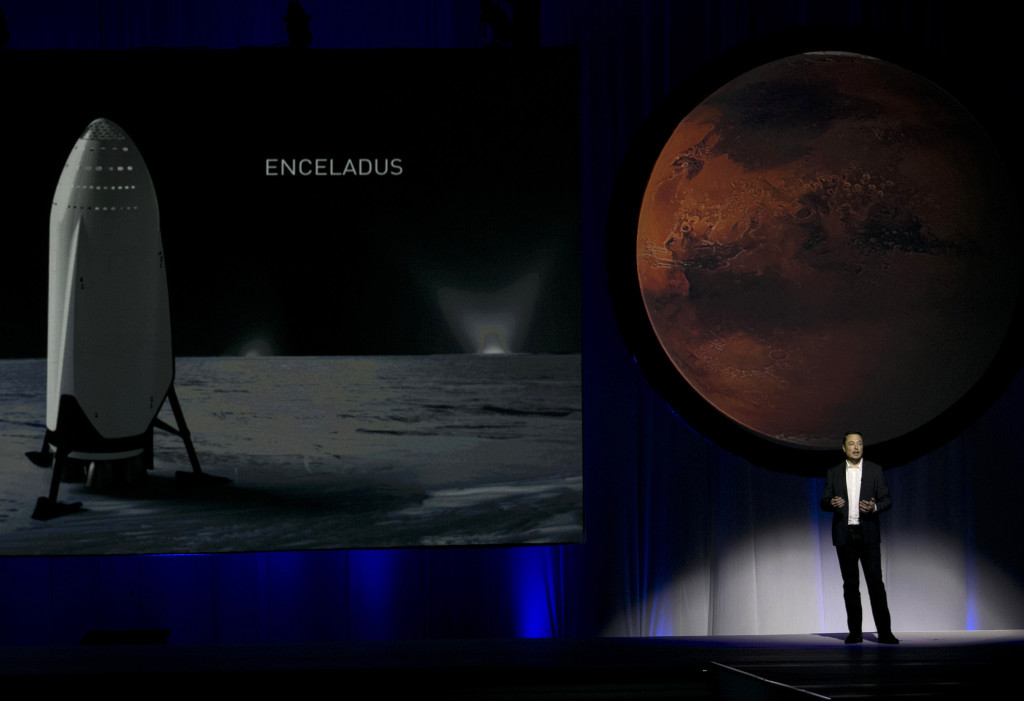SpaceX chief envisions 1,000 passenger ships flying to Mars

SpaceX founder Elon Musk speaks during the 67th International Astronautical Congress in Guadalajara, Mexico, Tuesday, Sept. 27, 2016. In a receptive audience full of space buffs, Musk said he envisions 1,000 passenger ships flying en masse to Mars, ‘Battlestar Galactica’ style. He calls it the Mars Colonial fleet, and he says it could become reality within a century. Musk’s goal is to establish a full-fledged city on Mars and thereby make humans a multi-planetary species. AP
CAPE CANAVERAL, Florida — On a personal quest to settle Mars, SpaceX founder Elon Musk envisions 1,000 passenger ships flying en masse to the red planet well within the next century, “Battlestar Galactica” style.
Musk outlined his zealous plan Tuesday to establish a self-sustaining city on Mars, complete with iron foundries and even pizzerias. He wants to make humans a multiplanetary species, and says the best way to do that is to colonize the red planet.
“I think Earth will be a good place for a long time, but the probable lifespan of human civilization will be much greater if we’re a multiplanetary species,” he said.
Musk, who also runs electric car maker Tesla Motors, received a wildly warm reception at the International Astronautical Congress in Guadalajara, Mexico. Many in the crowd were avid space buffs.
For now, the aerospace company he founded in 2002 is focusing on satellite deliveries, as well as space station cargo runs for NASA and a future crew capsule for U.S. astronauts. Its Falcon rocket, though, is grounded for the second time in a year because of devastating accidents.
During his address, Musk did not mention the Sept. 1 launch pad explosion that destroyed a Falcon rocket and its satellite.
Instead, he noted that SpaceX already has begun work on the Mars Colonial fleet, recently test-firing a powerful new rocket engine named Raptor. The system ultimately could take people to the moons of Jupiter and beyond, he said.
Musk said it would be a “super-exciting” adventure to Mars but also dangerous, at least for the first few trips. His goal is to get the price down so anyone could afford to go, with a ticket costing no more than a house on Earth. He’s shooting for 1 million Martians.
READ: SpaceX vows to send capsule to Mars by 2018
Would he go, someone asked? Perhaps ultimately, but it would depend on whether he had a good succession plan in place. As for being the first Martian, the risk of fatalities will be high — “there’s just no way around it” — and he wants to see his five young sons grow up.
“It would be basically, are you prepared to die? If that’s OK, then you’re a candidate for going,” he told the audience.
In April, Musk announced plans to send an unmanned Dragon capsule to land on Mars as early as 2018. NASA is offering technical support, but no money. The space agency has its own program to get astronauts to Mars in the 2030s, using its own hardware.
Musk invited industry to join the Mars effort, which will represent a $10 billion investment. SpaceX currently is spending a few tens of millions of dollars on the enterprise, and the amount will soon grow, he said.
Musk described in detail his plans to launch a monster-size rocket — larger than even NASA’s Saturn V moon rocket — from the same launch pad at Kennedy Space Center from which the Apollo astronauts departed for the lunar surface in the late 1960s and early 1970s.
The first-stage boosters would return to land vertically — just like his Falcon rocket boosters do now. Reusability, in fact, is essential to any plan for getting humans to Mars, as is refilling fuel tanks in Earth orbit and creating rocket fuel at Mars for return trips, he said.
The rocket would hoist a spaceship big enough to carry 100 to 200 people to Mars, a trip lasting several months, quicker with nuclear propulsion. Musk promised no one would be stuck there; spaceships would return regularly, and “you get a free return trip if you want.”
“Ultimately what I’m trying to achieve here is to make Mars seem possible, make it seem as though it’s something that we can do in our lifetimes,” he said.